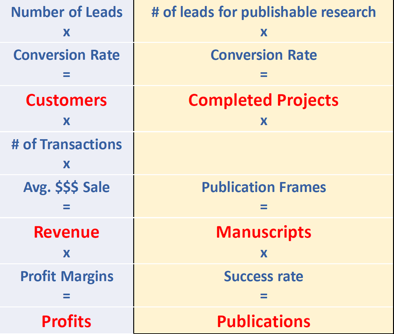Pipeline thinking
Khandis has a background of business coaching. In her workshop, she drew parallels between sales pipelines and research projects (Fig. 1). She discussed one can increase customers, revenue and profits or in research terms – the number of completed studies, submitted manuscripts and publications by working on factors that affect these key things.
Now, once a business has converted a lead to paying customer, one can increase the number transactions per sale, which will increase revenue. Think “Would you like to have fries with that?”, a line we are all too familiar with. The research equivalent of this is the idea of publication frames i.e. number of manuscripts one can address in a single project. Can you partition your data in multiple ways to test multiple hypotheses? Can you collect just a little bit more data (with minimal effort) so you can address another interesting question? Depending on the of results, can you segment these to tell more than one cohesiveness story?
Finally, to ultimately increase the number of publications– your manuscripts need to be submitted. Your success rate depends on a range of factors, some of which are not in your control (e.g. time in review) but you can increase your chances by making sure the story is clear, concise and well written; stick to journal guidelines; a fast turnaround with revisions or resubmissions to another journal.
But there is a catch with the research pipeline…
The lag in research
Khandis emphasised that the research pipeline is long one. The time from a conceived idea to data collection, to manuscript submission and submitted and acceptance is LONG. For example, I started the data collection in early December 2014 for a paper that was accepted earlier this month (3-year pipeline!!!). This means that there is always a lag in productivity and in order to avoid lulls, here are some tips:
- Khandis’ top tip is to always keep that pipeline full. Network for collaborations, read for new ideas, collect and analyse data and always be writing something. It is that uncomfortably simple.
- Have a mental reminder of the current state of your pipeline (See mine as an example in Fig. 2).
- Backwards plan your tasks, e.g., if your goal is to have a study analysed, written up and submitted in 18 months, then data collection needs to start next month, but you need permits which need to be applied for this week!




 RSS Feed
RSS Feed